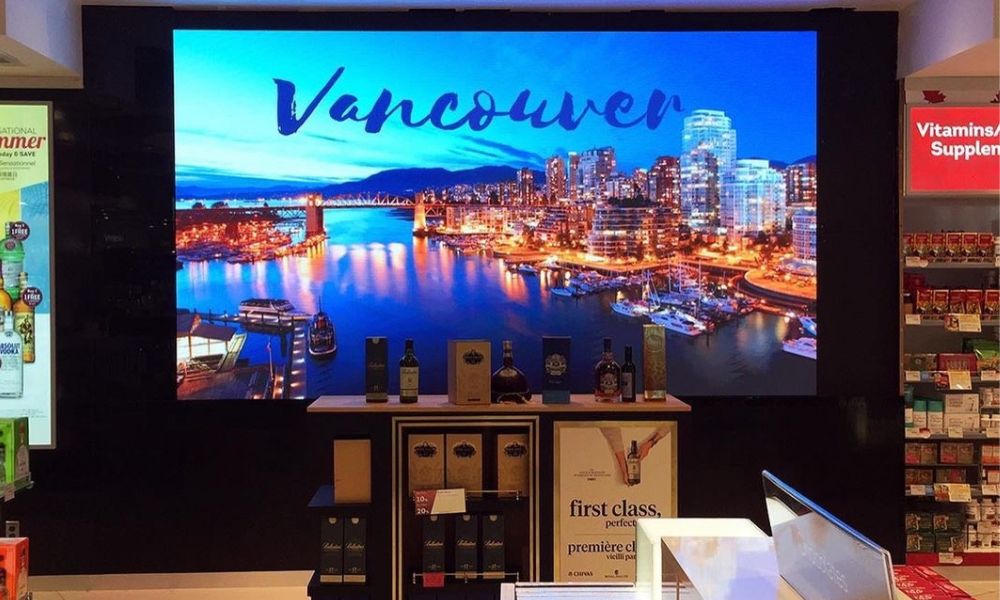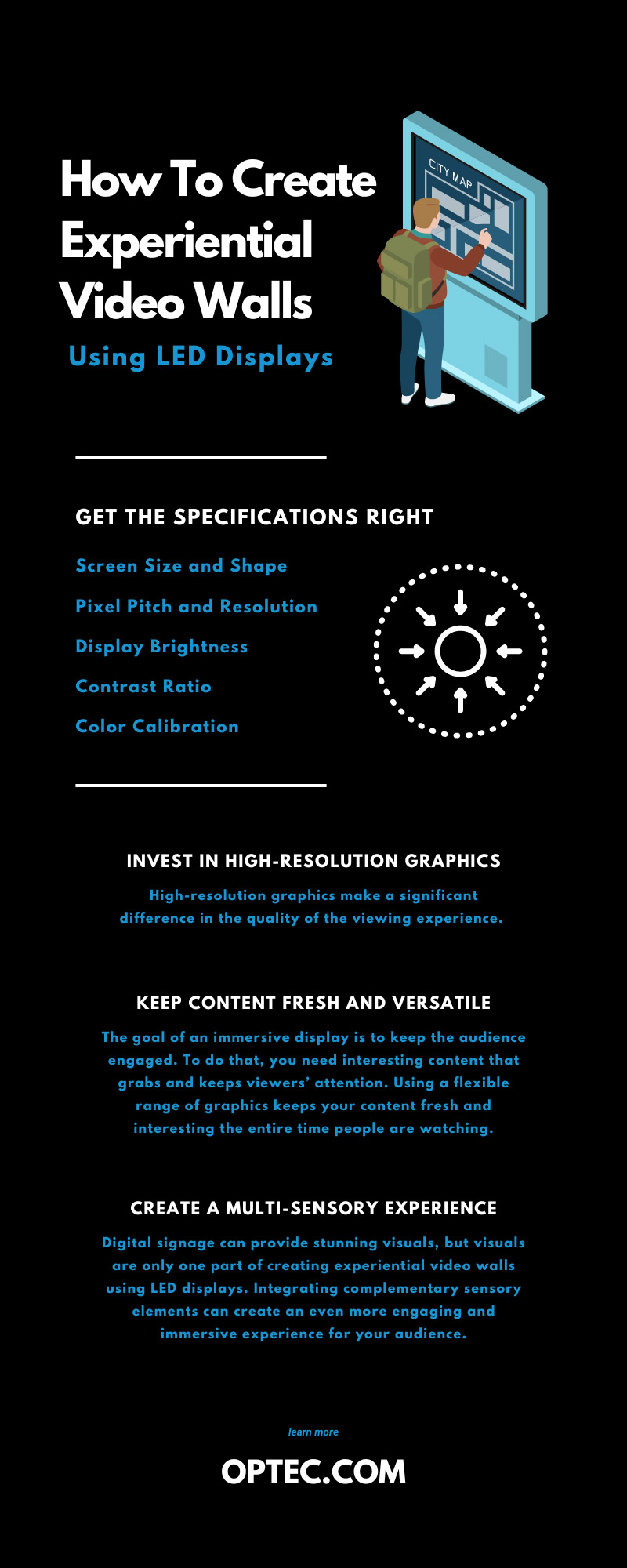How To Create Experiential Video Walls Using LED Displays

Immersive content draws viewers in and makes a greater impact on consumers. Learn how to create experiential video walls using LED displays with this guide.
Creating Experiential video walls using LED signage has become increasingly popular in various industries, from entertainment to retail. With their vibrant colors and dynamic visuals, digital displays have the power to captivate and engage audiences like never before.
In this blog, we will explore the key steps and strategies to help you unlock the full potential of LED displays and create a truly unforgettable experience for your viewers. Whether you’re organizing an event, designing a retail space, or looking to enhance your brand presence, these valuable insights and practical tips will help you revolutionize your visual storytelling. Discover the true potential of your signage solution with this guide on how to create experiential video walls using indoor, full-color LED displays.
Get the Specifications Right
First and foremost, you want to make sure the screen itself is perfect. All your design specifications should work toward creating a vibrant, dynamic, and eye-catching display that takes your content to the next level. Here are a few things to keep in mind.
Screen Size and Shape
One of the first aspects to consider is the size and shape of your LED digital display. The ideal size and shape of your screen will depend upon factors such as the location of the display, how many viewers you’re anticipating, and the type of content you’ll be showcasing. For example, a sprawling video display in a store may require a seamless LED wall like our versatile, bezel-free Opt Slim display.
Take time to assess your mounting location and the angle and distance from which your audience will be viewing the digital display. This will help you determine an appropriate screen size that’s captivating, easily legible, and comfortable to look at.
Pixel Pitch and Resolution
Pixel pitch refers to the distance between individual pixels on an LED screen, while resolution defines the overall clarity and sharpness of your display. A smaller pixel pitch results in more pixels overall, which means a higher resolution that creates crisper, clearer visuals.
For up-close viewing, like in retail spaces, prioritize a fine pixel pitch for a smoother image. But when you have your LED display mounted at a greater distance, such as at sports arenas, a larger pixel pitch can still deliver clear visuals without unnecessarily increasing costs.
Display Brightness
Brightness directly impacts the visibility and vibrancy of your LED digital display. Once again, the location of your signage will influence what kind of brightness requirements you should look for. Outdoor signage or displays in bright rooms with a lot of natural light require higher maximum brightness levels to be visible. If lighting conditions around your display change throughout the day, investing in automatic brightness adjustment can help you save energy and keep your signage clear and visible all day long.
Contrast Ratio
Achieving the right contrast ratio, the difference between the brightest and darkest parts of your display, is paramount for vibrant and easily discernible visuals. A high contrast ratio ensures that your content pops out from the background, making it more engaging and appealing to your audience. Higher-quality LED digital displays typically boast a greater contrast ratio, delivering more striking and lifelike visuals, which should be a vital consideration in your decision-making process.
Color Calibration
Accurate color calibration is also crucial for your LED digital display to reproduce colors consistently across all screens. This will ensure your content looks sharp, vivid, and true to its original design.
Pay Attention to Your Location
Every venue is different, which means there’s no one-size-fits-all display solution. The more familiar you are with your location, the more informed your decision will be when purchasing the right digital signage solution. Your location will influence viewing distance and angle, screen size, resolution, the type of content you want to work with, and so on. Be sure to consider factors such as natural light, available space, and architectural elements when scoping out your location and designing your display.
Invest in High-Resolution Graphics
High-resolution graphics make a significant difference in the quality of the viewing experience. Whether it’s still images, text, videos, or a combination of all of them, you need to make sure all of your content is crisp, clear, and vibrant. Remember that most immersive displays are close to the viewer, so have bright, believable visuals that capture the viewer’s attention and draw them into the world you’re creating with your content.
Keep Content Fresh and Versatile
The goal of an immersive display is to keep the audience engaged. To do that, you need interesting content that grabs and keeps viewers’ attention. Using a flexible range of graphics keeps your content fresh and interesting the entire time people are watching. Try incorporating detailed images to draw people in, charts and graphs to share information, and animations and videos to keep viewers engaged. Experiment with various types of content to find what works best for your audience. Keep an eye on trends and consistently update your content to ensure it stays relevant and engaging.
Think About Integration
These specifications and designs are useless if your display doesn’t fit seamlessly into its environment. That’s why you should prioritize cutting-edge LED solutions with modular designs that can meet the needs of any space. From sweeping panoramic displays in large-scale settings to attention-grabbing signage in more intimate settings, LED panels are flexible enough to match and enhance any environment.
Create a Multi-Sensory Experience
Digital signage can provide stunning visuals, but visuals are only one part of creating experiential video walls using LED displays. Integrating complementary sensory elements can create an even more engaging and immersive experience for your audience. For example, seamless syncing with high-definition sound systems can bring the visuals to life and create a more satisfying and memorable experience.
You can also engage your audience by incorporating scents that can evoke specific emotions or settings, like the smell of fresh coffee in a café scene. Additionally, tactile experiences, such as vibrating seats or interactive displays, can engage your audience in a more hands-on way. Special effects like fog, wind, or lighting changes can also create a multi-sensory experience that stands out.
How Immersive Displays Benefit Various Industries
LED displays aren’t industry-specific. In fact, various sectors can unlock their potential by integrating immersive displays into their marketing and customer engagement strategies.
For businesses in the retail sector, LED displays can elevate product showcases by creating visually striking presentations. Event organizers can enhance live experiences by incorporating mesmerizing visuals in concerts, festivals, theater performances, or other gatherings. Hotels and other hospitality establishments can leverage immersive LED displays to transform hotel lobbies into captivating spaces that evoke a sense of luxury while also providing information to help the guest experience.
How will your business create immersive content and unforgettable experiences with digital signage? Discover the endless possibilities available to you when you upgrade to Optec Display’s signage solutions. Visit us today and explore our range of indoor, full-color LED display options.


